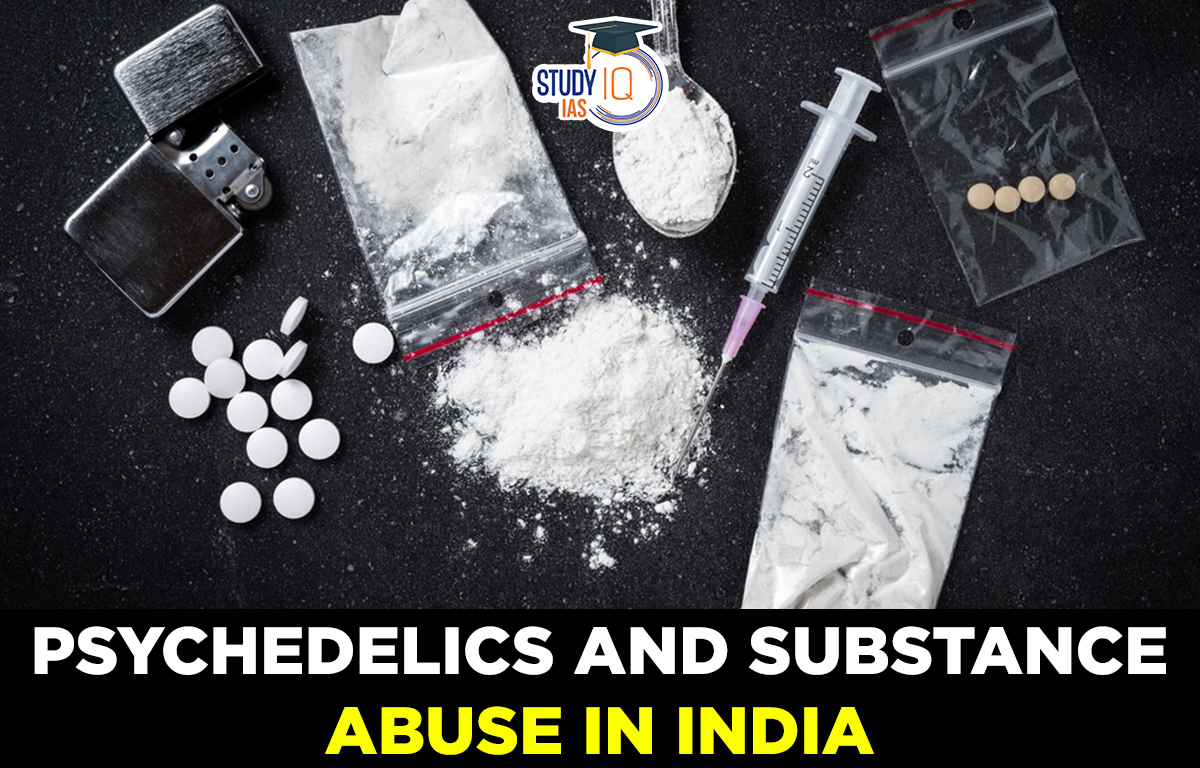Table of Contents
Context: Psychedelics, banned in India under the Narcotic Drugs and Psychotropic Substances Act, are emerging in research as promising ways to treat treatment-resistant depression and post-traumatic stress disorder.
What are Psychedelics?
- Psychedelics are a group of drugs that alter perception, mood, and thought-processing while a person is still clearly conscious. Usually, the person’s insight also remains unimpaired.
- They are non-addictive, non-toxic and compared to illicit drugs, they are less harmful to the end user.
- Some common examples of psychedelic substances include LSD (acid), psilocybin (magic mushrooms), DMT (ayahuasca), and mescaline (peyote).
- In India, the Narcotic Drugs and Psychotropic Substances (NDPS) Act, 1985 prohibits the use of psychedelic substances.
- However, Ketamine, a dissociative anaesthetic with psychedelic properties, is used under strict medical supervision, for anaesthesia and treatment-resistant depression.
How do the Psychedelic Drugs work in the body?
- Psychedelic drugs work by affecting the brain’s neurotransmitter systems, particularly the serotonin system. Serotonin is a neurotransmitter that is involved in the regulation of mood, cognition, perception, and other physiological processes.
- Psychedelics bind to serotonin receptors in the brain, which can lead to changes in perception, thought, and mood.
- Specifically, psychedelics are believed to activate the 5-HT2A receptor subtype, which is involved in modulating sensory perception, emotion, and thought processes.
- Modern neuroimaging suggests that psychedelics are neither stimulants nor depressants of brain activity. Instead, they increase the cross-talk between different brain networks, and this correlates with the subjective effects of psychedelics.
Can Psychedelics be used to treat Neuropsychiatric Disorders?
- In November 2022, the results from a phase II psilocybin trial were published in the New England Journal of Medicine.
- The trial found that a single 25-mg dose of psilocybin reduced depression scores over three weeks in people with treatment-resistant depression.
- Other potential benefits with psychedelics:
- Therapeutic benefits: Psychedelics have shown promise in the treatment of various mental health conditions, including depression, anxiety, and addiction.
- Spiritual and personal growth: Some users report that psychedelics have helped them gain new insights and perspectives on themselves and the world around them, leading to personal growth and spiritual experiences.
- Creative inspiration: Psychedelics have been associated with increased creativity and artistic expression in some users.
Concerns associated with Psychedelics
- Risks of adverse effects: Psychedelics can have serious adverse effects, including hallucinations, paranoia, and dissociation.
- Risks with Synthetic psychedelics: Synthetic psychedelics (such as 25I-NBOMe) have been associated with acute cardiac, central nervous system, and limb ischaemia, as well as serotonin syndrome. There have also been reports of death attributed directly to synthetic psychedelic use.
Narcotics v/s Psychotropic Substances
- The term “narcotic” in the legal sense is quite different from the one used in the medical context which denotes a sleep-inducing agent.
- Legally, a narcotic drug could be an opiate (a true narcotic), cannabis (a non -narcotic), or cocaine (the very antithesis of a narcotic, since it is a stimulant).
- Mind-altering drugs such as LSD, phencyclidine, amphetamines, barbiturates, methaqualone, benzodiazepines, mescaline, psilocybin, and designer compounds are referred to as “psychotropic substances” (MDMA, DMT, etc.).
What is Substance Abuse?
- The excessive use of a substance, especially alcohol or a drug is known as substance abuse.
- Impacts of substance abuse:
- Substance abuse disrupts bodily functions and has numerous side effects.
- Substance abuse causes health problems like lack of interest in things, change in behaviour, no drive to take part in self-care, spending more time alone etc.
- In India it is a crime to use any banned substance and also selling and consuming it is a criminal offence, and there is a huge penalty as well as a jail term.
- The most common substances used in India are alcohol, heroin, ganja, marijuana and cocaine. But there is an increasing prevalence of methamphetamine too.
- Source of drugs in India:
- Opiate trafficking in India takes place from Central Asia/Transcaucasia, through Afghanistan, the Islamic Republic of Iran and Pakistan.
- India is one of the main countries in which heroin was trafficked between 2014 and 2018 along with Qatar, the United Arab Emirates, and several African countries.
Prevalence of Substance Abuse in India
- According to the National Survey on Extent and Pattern of Substance Use in India in 2019, about 2.1% of the country’s population (2.26 crore individuals) uses opioids which include opium (or its variants like poppy husk known as doda/phukki), heroin, and pharmaceutical opioids.
- The national survey of 2019 also showed that about 2.8% of Indians aged 10-75 years (3.1 crore individuals) were using cannabis as bhang, ganja and charas.
- But what is alarming is the number of suicides due to drug abuse and alcohol addiction has more than doubled in the last decade in India. In the year 2010, 3,343 cases of suicides were reported, and the number increased to 7,860 suicides in 2019.
- Highest percentages of rural drug abusers were in Goa (78.0%) and Punjab (77.5%). Highest number of urban drug abusers were reported in Mizoram (91.0%) and Meghalaya (90.7%).
Which act deals with Substance Abuse in India?
- The Narcotic Drugs and Psychotropic Substances Act, 1985, was enacted with stringent provisions to curb this menace.
- The Act was enacted “to consolidate and reform legislation pertaining to narcotic drugs, as well as to provide strict measures for the control and regulation of Narcotic Drugs and Psychotropic Substances activities.”
- Key features of the Act:
- The legislation makes it illegal “to produce, manufacture, cultivate, own, sell, transfer, purchase, or consume any Narcotic Drugs and Psychotropic Substances”.
- The Act extends to the whole of India and it applies also to all Indian citizens outside India and to all persons on ships and aircraft registered in India.
- Initially, there were no Special Courts however, by an amendment in 1989, now the Government can establish Special Courts and there will be one single Judge who has powers to take cognizance of all the offences under the NDPS Act.
- One of the key features of the NDPS Act is, not only is the consumption of drugs an offence, but possession of drugs is an offence, as well.
- Punishment for the offences will depend on the quantity of drugs involved in the case. The NDPS Act categorises drug quantity into 2 types. One is a Small Quantity and the other one is Commercial Quantity.
- Another feature of the NDPS Act is Section 31A which prescribes the death penalty, for repeated offences or certain rare cases.
- There are also some special provisions for addicted persons prescribed under the NDPS Act.
- Section 64A of NDPS Act provides “immunity from prosecution to addicts volunteering for de-addiction treatment.
- Narcotics Control Bureau was established in 1986 as per the NDPS Act, it is the apex body that regulates drug trafficking in India.
Government Initiatives to tackle Substance Abuse in India
- Government has also announced the launch of the ‘Nasha Mukt Bharat’, or Drug-Free India Campaign which focuses on community outreach programs.
- The government has constituted a fund called “National Fund for Control of Drug Abuse” to meet the expenditure incurred in connection with combating illicit traffic in Narcotic Drugs; rehabilitating addicts, and educating the public against drug abuse, etc.
- The government is also conducting a National Drug Abuse Survey to measure trends of drug abuse in India through the Ministry of Social Justice & Empowerment with the help of National Drug Dependence Treatment Centre of AIIMS.
- ‘Project Sunrise’ was launched by the Ministry of Health and Family Welfare in 2016, to tackle the rising HIV prevalence in north-eastern states in India, especially among people injecting drugs.
- India is a signatory of the following International treaties and conventions;
- United Nations (UN) Convention on Narcotic Drugs (1961).
- UN Convention on Psychotropic Substances (1971).
- UN Convention against Illicit Traffic in Narcotic Drugs and Psychotropic Substances (1988).
- UN Convention against Transnational Organized Crime (UNTOC) 2000.


 Gujarat Bridge Collapse: 9 Dead as Gambh...
Gujarat Bridge Collapse: 9 Dead as Gambh...
 Phone-tapping in India, Legal Framework ...
Phone-tapping in India, Legal Framework ...
 Bihar Assembly Election 2025 Dates, Poli...
Bihar Assembly Election 2025 Dates, Poli...





















